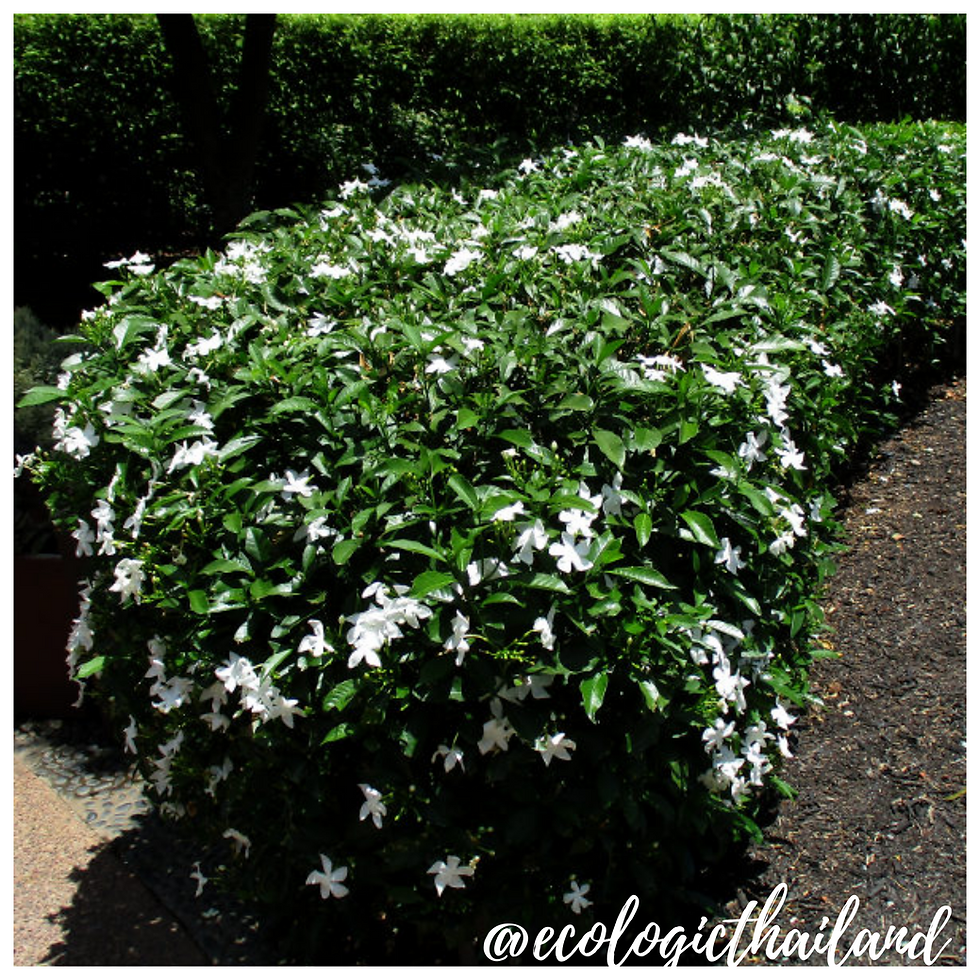Cananga tree | Ylang ylang
- Eco-Logic Resort
- Jan 16, 2021
- 3 min read
Kradangnga | กระดังงา | Cananga odorata
Family: Annonaceae - Genus: Cananga

The Ylang Ylang tree can be found on the premises of TCDF-Eco-Logic and in Paksong area.
The cananga tree is fast-growing, straggling, pendulous evergreen tree that normally grows up to 40 meter tall with a trunk diameter of 75 centimeter with an irregularly-shaped crown and a sometimes drooping, brittle branch formation.
It is valued for the perfume extracted from its flowers, called ylang-ylang (a name also used for the tree itself), which is an essential oil used in aromatherapy. The tree is also called the fragrant cananga, Macassar-oil plant, or perfume tree.
The ylang ylang flowers in December and January.

THE PLANT
It is a fast-growing tree of the custard apple family. Its growth exceeds 5 meter per year, and it can grow up to 40 meter.

THE LEAVES
The evergreen leaves are smooth and glossy, oval, pointed and with wavy margins, and 13–21 centimeter long.

THE FLOWERS
The flower is drooping, long-stalked, with six narrow, greenish-yellow (rarely pink) petals, rather like a sea star in appearance, and yields a highly fragrant essential oil.
.
The essential oil made from the ylang ylang flowers is used in aromatherapy. It is believed to relieve high blood pressure and normalize sebum secretion for skin problems, and is considered to be an aphrodisiac. The oil from ylang-ylang is widely used in perfumery for oriental- or floral-themed perfumes (such as Chanel No. 5). Ylang-ylang blends well with most floral, fruit and wood scents.
The tree doesn’t flower for its first five years; after this it goes on to produce an amazing 45 pounds of flowers for around fifty years!

THE FRUIT
The fruit of the ylang ylang tree is 1.5-2 centimeter long, 1.3-1.4 centimeter in diameter, broadly ellipsoid to broadly obovoid, purple-black and juicy when ripe.
Several fruits develop from each flower.
The fruit is dark green when young turning to black when ripen
The fruits are eaten by small mammals such as squirrels, bats, monkeys and birds.
CULINARY USES
Ylang-Ylang fruits are not used in foods; however they are quite edible and have the tart but pleasant aroma of a conifer or juniper.
The essential oil from the flowers is used by the food industry, especially in peach and apricot flavorings. It is used in candies, icings, baked goods, soft drinks and chewing gum.
TRADITIONAL MEDICINAL USE OF NEEDLE FLOWER
NOTE: please take advice from a doctor if you are planning to use herbal medicine.
The flowers, and the essential oil obtained from them, are antipruritic, antifungal, antiseptic and sedative, relieving tension, lowering blood pressure and reducing fever.
They are also said to be aphrodisiac.
The dried flowers are used in the treatment of malaria and the fresh flowers are made into a paste for treating asthma. Applied externally, they are used to treat skin irritations, conjunctivitis, boils and gout. They are added to bath water to treat impotence and frigidity.
The essential oil from the flowers is important in aromatherapy, where it is used in the treatment of tachycardia, rapid breathing, hypertension, gastrointestinal infections and psycho-sexual complaints.
The leaves are used in a treatment for diarrhea in infants. The leaves are also used in a remedy for treating boils. They are rubbed on the skin to treat itch.
The bark is applied against scurf. An infusion of the bark is used for treating stomach ailments such as pains, indigestion and colic. Fluid from the pressed bark is used in treating toothaches and migraine headaches.
The seed has been used externally to cure intermittent fever.
INTO THE WILD: a down to earth experience

For guests and visitors to Paksong we organize weekly tours "The Edible Forest" and Foraging weekends: Into the Wild. We work with local guides to take you in the jungle of Paksong. After foraging, we will cook a meal with the ingredients, using bamboo together with you!
Come and join and learn about the abundance of food that nature gives us!
INTO THE WILD!


















Comments